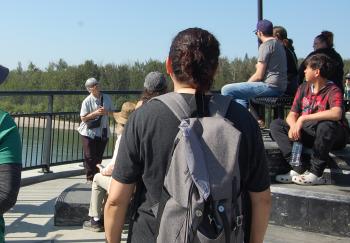Image Caption
Summary
Local journalism initiative Reporter
Windspeaker.com
This past Saturday morning, with blue skies and closing in on a high of 24-degrees, Deborah Auger and her 14-year-old twins Ethan and Emma joined about 30 others on an Indigenous-led walk in the North Saskatchewan River Valley in Edmonton.
“We're just trying to get some knowledge and also get some exercise in,” said Auger, a member of the Bigstone Cree Nation. She was born in Edmonton and has resided in the city for the past 30 years.
Auger said she and her children share the same level of knowledge of their Cree culture.
“I've been trying to incorporate as many cultural events for them…Things that are going to educate them and help them to feel proud of who they are,” said Auger.
“Being in the system, I noticed that they already have that… full-on shame. They also have this hesitancy of saying what their nationality is and I don't want them to do that, so I’ve just been trying to educate myself and them.”
Auger and her children were among a handful of Indigenous participants in the first of three Indigenous-led walks, which are part of the Saunter Program. It’s hosted by the Prairie Chapter of Sierra Club Canada and is sponsored by Alberta Ecotrust.
The Saunter Program provides “a space and a voice to our Indigenous communities to share their stories and our urban parklands,” said Paulina Retamales, an educator and coordinator with Sierra Club Canada.
She said the club hopes to connect with more Indigenous communities in the future. However, she is pleased with the turnout, noting that there were at least 20 people on the waiting list.
“I think Edmontonians and the public are very interested in learning, and I think it's part of that truth and reconciliation to be part of this, and learning and sharing the Indigenous culture,” said Retamales.
Auger said she was both surprised and pleased to see the high non-Indigenous turnout.
“It kind of threw me off. I also appreciate it and I understand that this is how change happens. This is how reconciliation does happen,” she said.
The walk was led by Naomi Mcilwraith, a Cree-Ojibwe-Métis poet and narrative supervisor at the Indigenous Peoples Experience at Fort Edmonton Park.
“I was born here and I'm a writer, and I actually have a special relationship with the North Saskatchewan River,” said Mcilwraith.
In 1989 when she was earning her degree in Physical Education, Mcilwraith and a group of University of Alberta students canoed the North Saskatchewan River from Rocky Mountain House in west-central Alberta to where it spills into Lake Winnipeg, and continuing all the way to Thunder Bay in Ontario.
“This (North Saskatchewan) river has brought people here for thousands of years, and without the river we wouldn't be in relationship with the river or with each other,” said Mcilwraith.
Before the walk, Retamales presented Mcilwraith with tobacco and a red cloth, representing missing and murdered Indigenous women and girls. Mcilwraith invited the group to smudge.
In her land acknowledgement, Mcilwraith spoke about those just as able to feel as humans do, including the rivers, trees, pathways, stones, mountains, lakes and grasslands which “have imbued my life with meaning and enriched me beyond measure.”
“This is our purpose today…to foster meaningful conversations about the land, the river and our deeper relations as human relatives,” said Mcilwraith.
She encouraged walkers to “imagine ourselves as trees. What do your feet feel? What do your legs and your body feel?... As you walk today, try to imagine your feet as roots.”
For Vincent LeHaye, a non-Indigenous participant, “one of the most impactful things was our challenge to picture ourselves as trees walking through the forest. I've done a lot of work to overcome my own personal traumas in the past and part of that involves similar visioning.
“Being able to connect my own personal healing to this place of healing that people have come to for millennia, it's very special and lots to reflect on in a very positive way.”
LeHaye, a community consultant and engineer for almost 20 years, primarily works for Indigenous communities. He said participating in the walk is an opportunity to listen and learn from people who have called the land home forever.
“I know that I've got a lot of work to do to come to terms with my own background as descendants of settlers and the relationship that they had with the land and how that's impacted my own,” said LeHaye.
He observed that the average age of participants was in their 50s. He said that was an indication of both the lack of education that was received in the school system and the “growing awareness of the amount of work to be done in terms of reconciliation. I think that it speaks to a desire to learn more about the history of this place and the people that have called it home.”
He applauded Sierra Club Canada for providing the opportunity.
Retamales said the hope is to continue with the Saunter Program. She said they would be applying for more funding and would like to increase the walks to year-round.
Two more walks are scheduled for August. The next walk will be led by Dr. Dwayne Donald, Cree educator and Canada research chair at the University of Alberta with insight on “Ancient and Recent Edmonton.” The final walk, “Through the Trees with Chickadee,” will be led by internationally-acclaimed local Métis artist and educator Krista Leddy.
Both walks are filled to capacity at this point with waiting lists.
Local Journalism Initiative Reporters are supported by a financial contribution made by the Government of Canada.

